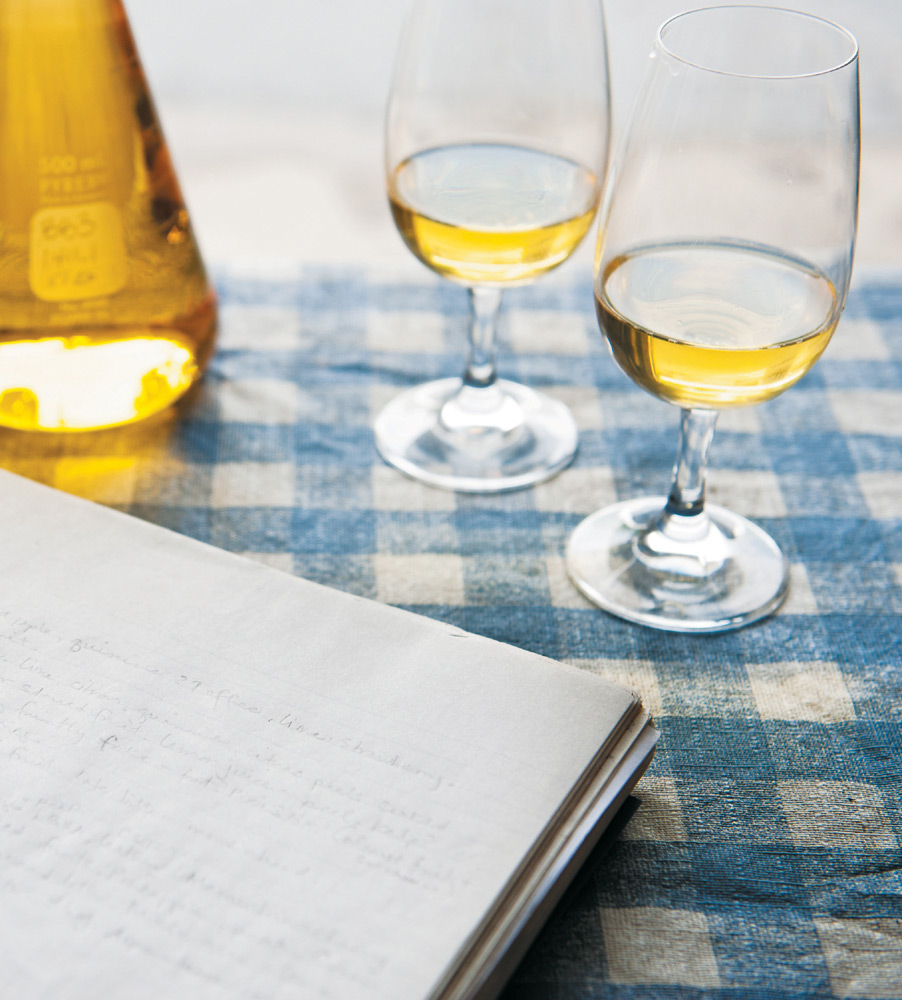CHAPTER 2
Tasting Cider
Tasting cider is an important part of cidermaking.
You can learn the most from your cider tasting if you develop a procedure and a vocabulary for tasting that controls as many variables as possible and allows for consistent and objective evaluation of each batch of cider. The process in this chapter was developed over many years by the Farnum Hill Ciders crew.
Tasting begins with the apples, happens again when the apples are blended and pressed, when the fermentation is completed, when cider is racked, when the fermented batches are blended, and as the cider matures. The apples and the juice are very different from the fermented cider, showing fewer nuances and different flavors. The crew regularly tastes other people’s cider, which they refer to as OPC, to learn from other cidermakers.
During the tasting process, the cidermakers do not pass judgment on a cider. That comes later when they make decisions about what to blend and sell. During the tasting process, they are intent only on describing it. And the descriptions they use to do so—be it “honey” and “sweet cream” or “forest floor” and “barnyard”—are viewed as neither positive nor negative.
It takes some practice to become comfortable with applying an objective standard of evaluation to the fundamentally subjective topics of smell and taste. But this process is as indispensable to the home cidermaker as it is to commercial cidermakers.
You should plan to taste lots of cider to train your senses and begin to understand the different types of cider available. You should also plan to taste the apple juice before you begin the fermentation process and to taste the cider when fermentation is complete. If you plan to let the cider sit on the lees or to mature before bottling, you may choose to taste the cider at other times in the cidermaking process. (Learn more about these topics in chapter 5.)
It takes a lot of practice, too, not to let the tasting process affect your enjoyment of cider. When you are conducting a tasting, do so carefully and analytically. When you pour a cider after work, just drink it.
PREPARING FOR A TASTING
When preparing for a tasting, it is important to control as many variables of the experience as possible. You are looking for changes in the juice and cider over time, so you want to ensure that the changes you perceive in the glass are not a result of changes in the environment.
Where to Taste
If possible, taste in a room that is free of noticeable aromas. (For instance, tasting in the kitchen while dinner is cooking is not the best choice.) Similarly, you don’t want to be wearing strong perfumes or using strongly scented soap during the tasting. And don’t taste with food, which will change your perception of smell, taste, and sensation.
Equipment
You will need some easy-to-find equipment for the tasting: cider; plastic tubing; a clean pitcher for cider; dry cider, neutral white wine, or distilled water, as needed to top off the fermentation container; a bucket filled with warm water; a thermometer; clean tasting glasses; a spit bucket; and a notebook.
Using the same style of glasses for each tasting is another way of controlling external variables. The style of glass will affect your perceptions. A overly narrow glass, such as a Champagne flute, leaves little room for your nose, decreasing your access to the aromas, while an overly wide glass, such as a white wine glass, allows the more volatile aromas to dissipate quickly. The best glasses for tasting juice and cider are standard wine-tasting glasses, which have a wide cup that narrows toward the opening. The wide cup allows you to easily swirl the liquid and release aromas, and the narrower opening funnels the aromas while leaving room for your nose.
You will also want to use the same notebook for each tasting. You’ll want to compare your notes to learn more about your cider and your senses. For the same reason, it’s also ideal to taste with the same people each time.
Collect all the equipment you need before beginning the tasting.
PREPARING THE CIDER
The plastic tubing will be used to siphon some cider into the pitcher. You want about 2 ounces (60 ml) of cider per taster. If you take too much cider from a carboy, you will have to use more dry cider, neutral white wine, or distilled water to replace it. If you take too little cider, you won’t be able to fully evaluate it.
If you are tasting cider that has finished fermenting, it’s important to replace the removed cider with another liquid to fill the carboy completely and minimize exposure to air. Add dry cider, neutral white wine, or distilled water before resealing the carboy.
If you are tasting bottled cider, you can pour the cider directly into the pitcher. Although you could skip the pitcher and pour directly from the bottle, tasters can be influenced by what they expect a cider to taste like; it’s best to remove visual clues, such as a distinctive bottle or label. Tasting blind removes another variable from the experience.
Place the pitcher or pitchers of cider in the bucket filled with warm water. The water bath will bring the cider to a proper tasting temperature more quickly, which means the cider will spend less time exposed to air, which can change its properties. The ideal tasting temperature is about 60°F (16°C), which might be slightly warmer than you would typically serve your cider. At or just above 60°F (16°C), the aromas, tastes, and sensations of a cider are stronger and any flaws are more noticeable. (See chapter 6 for more on the most common flaws.) Acidity is particularly temperature sensitive. Use the thermometer to ensure the cider is at the proper temperature.
When the cider reaches 60°F (16°C), you are ready to begin tasting.
THE TASTING PROCESS
Begin the tasting process by pouring a small amount of cider into each of the tasting glasses. Swirl the cider around in the glass and then dump the cider into the spit bucket. This removes any foreign aromas. If you are tasting multiple ciders in one sitting, it’s important to take this step between each one to avoid blending the ciders.
Now pour about 1.5 ounces (44 ml) of cider into each glass. This is the cider you will be evaluating.
Appearance
First, evaluate the appearance. Although the appearance of a cider does not always correlate with its other characteristics, making a brief note about the color—honey, straw, gold, or another descriptive that makes sense to you—will familiarize you with the range of hues typical in cider and help you recognize when a cider changes color in the maturing process. You can also note the clarity of the cider: Is it hazy or has it “dropped bright”?
Nose
Next you will evaluate the aroma, or nose. Swirl the cider in the glass to more fully release the aromas. Empty your mind of any preconceptions and smell the cider.
This is not a quick process. You may smell the cider for a minute or more, identifying different aromas and finding the right words to describe each of them.
In the cider room at Poverty Lane Orchards, the tasters begin calling out the aromas they smell. Because the cidermakers have been tasting together for a long time, they are comfortable agreeing with, refining, clarifying, or disagreeing with a description offered by someone else at the table. This process of verbalizing their notes has helped them develop a precise vocabulary for the tastings, a boon when you are tasting as many batches over as many years as they have.
For novice tasters, however, it may be best to start silently, with each taster writing down his or her notes before discussion begins. This prevents one taster’s experience from overwhelming the others’; the power of suggestion is strong.
Once you have smelled the cider, begin making notes. You will quickly notice that the aroma of cider is layered. There are certain scents that you experienced first and others that came later, regardless of the relative strength of those aromas. The goal is to list the aromas in the order you experienced them. If you don’t have the exact word for an aroma, list an approximate description with a questions mark as you experience it, and then return to it when you’ve completed the list. Stick your nose back in the glass and hunt for it again. Can you find a better description for it?
In this part of the process, conversation can be helpful. Describe the aroma in any terms that occur to you: a color, a sound, a sensation, or a memory. Your fellow tasters may recognize what you are describing and be able to help narrow in on a word. You want to be as exact as possible. Do you smell orange? Can you be more specific? Is it a navel orange or a clementine? Is it orange peel or orange juice or orange marmalade or orange popsicle?
As you taste you will develop a vocabulary of words that are unique to you and your fellow tasters. During a Farnum Hill Ciders tasting, the term BSA is often used. BSA is shorthand for bittersweet apples and describes the distinctive pear-like, leathery aroma of bins of bittersweet apples in storage. It is an aroma that the Poverty Lane Orchards crew is very familiar with, but it is unlikely that you, as a home cidermaker, have the same point of reference. You probably won’t use the term BSA in your tasting notes; instead, you’ll be challenged to find other words, with meaning to you and your fellow tasters, to describe the same experience.
Remember: You have a whole world of aromas to draw from—and not just food-related aromas. The Farnum Hill Ciders tasting notes are filled with comments about sweat and manure. (And those aren’t necessarily bad things.)
Taste
Human taste buds are a far more limited tool than you imagine them to be. The tongue can only perceive acid, bitter, sweet, sour, salty, and savory flavors. Your sense of “taste” is truly your nose at work again, perceiving the changing aromas of a food in your mouth. (For evidence, try tasting with your nose plugged.) This scientific distinction, however, is not all that important for cider tasting. In the tasting process, all of the tastes and aromas that you experience when you first put the cider in your mouth are considered to be the cider’s taste.
Taste the cider by drawing a small amount into your mouth. Don’t swallow it. Swirl it around and spit it into the spit bucket. This is akin to rinsing the glass. Now draw a mouthful into your mouth. Again: Don’t swallow the cider. Instead swirl it around to coat your mouth (this time because different parts of the tongue are more sensitive to different flavors) and suck in some air through your lips to aerate it. This takes some practice—and sounds silly—but the air helps release the aromas in your mouth.
Start by evaluating the acidity and bitterness of the cider. These are perceived by the tongue alone. Which of the two hits your senses first? How quickly does the other arrive? Cider tasting notes often read: “Acid over bitter” or “acid and bitter in balance.” Then describe the acidity and bitterness.
Because these are not aromas or flavors in the way they are usually defined, it can be difficult to find descriptive words. Most often, the Farnum Hill cidermakers use shape, size, or sensation descriptors. The acid may be “bright,” “round,” “sharp,” or “flat.” The bitter may be “broad,” “direct,” or “moderate,” among the many other descriptions that fill years of notebooks.
Now, describe the taste as you experience it. List the flavors in the order they appear, as you did with the aromas. Aim for precision in your description—“white grape,” “lemonade,” “lime zest,” “fruit cocktail,” “compost,” “leather,” “lumber”—without worrying that you’ve never tasted some of them.
Mouthfeel
Next consider the mouthfeel. Mouthfeel is the sensation of cider in the mouth. Specifically, you are evaluating the body of the cider and its astringency.
Astringency is different from bitterness, which is perceived by the tongue. Astringency is often described as a drying sensation in the mouth and is related to the tannins present. Describing these properties is straightforward once you have some experience tasting, as they are typically described in relative terms. The body of the cider is usually said to be “light,” “medium,” or “full.” The astringency is described on a scale from “slightly” to “moderately” to “very” astringent.
Like the evaluation of the nose, evaluating the taste and mouthfeel can be a several-minute process. If you want to, spit your first mouthful into the spit bucket and taste again to identify that elusive flavor.
Some tasters will swallow a small amount of cider, believing that the flavors change as they are swallowed (as in beer tasting), but most spit as you would in a wine tasting. Spitting is an important part of the tasting process when you are tasting several ciders. The alcohol content of the cider is enough to change your perceptions as you go through the tasting process. Even when you do spit, a long tasting can wear you down.
Finish
After you spit the cider, you will taste its lingering effects, the “finish.” Most often, you’ll hear tasters say, “the finish follows,” meaning that the finish is a continuation of the taste of the cider. Sometimes, however, one taste will dominate the finish. Approach the finish the same way you approached the taste of the cider. Start by evaluating the acidity and bitterness. Which is apparent first? Then describe the flavors in the order you experience them, with attention to the differences between the taste and the finish. Does a flavor that was behind the scenes in the taste dominate in the finish? Does a flavor that was prominent in the taste disappear in the finish?
The word clean may be applied to the finish. In cider-tasting speak clean means that the cider is free of microbial defects and that the funkier, darker aromas and flavors of the nose have dissipated in the finish, leaving a bright, pleasant aftertaste.
TRAINING YOUR NOSE
Tasting takes practice. The best way to learn to confidently describe ciders is just to sit down and do it. Over time, you will develop your own vocabulary for the aromas, tastes, and sensations of cider.
You can also work to train your nose and your mind to identify scents more readily. Pay attention to the scents around you and the things that you eat every day and put words to those experiences. Everyone has his or her own methods for storing the information. For instance, some people, while smelling a honeydew melon, will repeat the word honeydew in their heads to solidify the mental connection. When you smell something interesting, seek out the source. A bouquet of flowers has a general smell, but each type of flower in the arrangement has a unique one. Smell each flower until you’ve located the hard-to-identify aroma and make a mental note of the experience.
DEFINING WHAT YOU LIKE
The tasting process is designed to be an objective one, but the end goal is subjective: The tasting process is a tool to help you create a cider you like. After you have objectively evaluated the ciders, review your notes. Which of the ciders did you like? Which of the ciders didn’t you like? What do the ciders in each category have in common?
The more you understand your own likes and dislikes, the easier it will be for you to make decisions about the types of apples you use in your cidermaking (see chapter 3) and your goals if you choose to blend cider (see chapter 7). The knowledge will also help you pick a cider you like from the shelves of your local liquor store while you wait for your own batch of cider to ferment or mature.
OTHER PEOPLE’S CIDER
The crew at Poverty Lane Orchards regularly taste their own cider as well as other people’s cider (OPC), to learn from fellow cidermakers’ successes and mistakes. The ciders listed here all share the cidermaking philosophy that cider should be an expression of the apple, but differ greatly in their approach to cidermaking and the desired result. If you have access to these ciders through your local liquor store, taste them yourself—remembering that cider varies from year to year—and make notes before reading on. If you don’t have access to these particular ciders, practice tasting on others available in your area. Following are Poverty Lane Orchards’ notes on tasting the featured ciders.
The distinct processes for making each of these ciders are outlined in chapter 7.
Still Cider—Farnum Hill Dooryard Still Cider 1312 (7.5% ABV)
Label and Website Description
From the label: “Farnum Hill ‘Dooryard Still’ refers to the big central yard at our home orchard … the label presents various nonbubbly dry ciders, some with rowdy tannins, some with edgy notes rare in U.S. ciders.”
From the website: “1312 is still, altogether dry, a lucky blend of several 2012 fermentations. Its tannic structure comes chiefly from Dabinett, Yarlington Mill, Major, and Somerset Redstreak; its fruitiness from Golden Russet; its acidity from Wickson, Ashmead’s Kernel, and Esopus Spitzenberg. Aroma through finish, we find peach and apricot (fresh and dried), pineapple, various citrus fruits, pear, smoke, and rocks, with pleasingly dynamic acid, tannin and fruit throughout.”
Tasting Notes
Appearance: Mid-straw, dead still, clear.
Nose: Peach, apricot (fresh and dried), orange and peel, marmalade, pear, smoke, rocks, grapefruit and peel, citron, dried leaves, leather (bittersweet apple), distant farmyard manure, lemon/lemon oil, general citrus, mango, papaya, faint stinky cheese, maybe horse, lime and peel, dust, wood (not oak), roses (the day before discard?), pineapple.
Taste: Bright acid in balance with broad bitter. Faint implied sweetness. Fresh and dried fruits from nose, especially citrus, citrus peels, dried apricot, peach, prominent bittersweet apple and pear, wood (not oak), broad distant funk in background (cheese/barnyard/dried leaves), behind acid/bitter and fruit.
Feel: Moderately full, moderately astringent.
Finish: Acid and bitter carry in balance, with fruits and funk from nose and taste. A bit more dried fruit, especially apricot, at the end. Clean.
French-style Cidre—E.Z. Orchards Willamette Valley Cidre 2011 (6% ABV)
Label Description
“E.Z. Orchards cidre consists of a blend of vintage French cidre apple varieties that we grow in our Willamette Valley orchards. Our fermentation method, like the traditional French méthode champenoise, enhances mature apple aroma, is low in acidity and finished with a soft effervescence. Chill upright before serving. To enhance clarity, pour gently to reserve the lees sediment at the bottom of the bottle.”
Tasting Notes
Appearance: Copper. Faint haze. Tiny rising bubbles.
Nose: Dried apricot and papaya, dried cranberry and cherry, peach, faintly acetic (nice vinegar), dried fruit/homemade fruit leather, cotton candy, avocado, wood, farmyard manure, orange and peels, brown sugar, lemon juice, horses, lanolin, peach pit, stewed pineapple, lime and seltzer, cream/orange and cream, acid heat, bark, forest floor, dried leaves.
Taste: Acid over sweet over bitter. Slightly acetic in mouth. Lime and seltzer, all fruits from nose (particularly dried cherry and cranberry), with vitamins, fish oil (taste, not smell), fresh and cooked apples.
Mouthfeel: Quite full, moderately astringent.
Finish: Acid and bitter in balance. Fruits from taste carry mostly in balance, animals fade. Strong peach. Clean.
Méthode Champenoise Cider—Eve’s Cidery Bittersweet (9% ABV)
Label Description
“This cider is made from a blend of traditional English, French and American cider apples. Like wine grapes, true cider apples have an ideal balance of tannins, acid and sugar needed to produce a fermented beverage. A secondary bottle fermentation creates natural carbonation. Golden, bubbly and semi-dry, Bittersweet is crisp and fruity with a hint of earthy tannins. Pairs well with most food. Served chilled.”
Tasting Notes
Appearance: Pale gold, rising bubbles, clear.
Nose: Apple concentrate, apples in cold storage. Sweet and tart. Pear. Fructose, grapefruit, McIntosh and baked apple, sweet fruit cocktail, vanilla, nutmeg and warm spice, cooked tropical fruits, guava paste/jam. Very concentrated fruit. Fried bananas, coconut (shell), cooked winter squash, green leaves, strawberry, warm pineapple.
Taste: Sweet, but more tart than expected from nose. Strong acid, sweet, then bitter. Mom’s apple pie, fresh bread/bakery (yeast), boiled apple cider, citrus peels, pink grapefruit, strawberry and leaves.
Mouthfeel: Full, moderate-high astringency, very fizzy.
Finish: Faithfully follows nose and taste. Acid and sweetness carry, bitter balanced in background. Apple (fresh, cooked, stored, and boiled), pear, guava jam, warm spice, warming alcohol. Clean.
Ice Cider—Eden Vermont Ice Cider Heirloom Blend (10% ABV)
Label Description
“Made from a unique blend of traditional and heirloom apple varieties, this delicious ice cider has a complex, balanced flavor and a long finish. 100% of the apples used are grown in Vermont. In addition to McIntosh and Empires, Russets proved full-bodied sweetness, Caville Blanc provides acidity and citrus notes for balance and Ashmead’s Kernel provides natural tannins for structure. Serve it with artisanal cheeses, charcuteries and desserts with autumn spices.”
Nose: Apple, pear, lemon oil, alcohol, very ripe peach, dried apricot, boiled cider, wood/furniture, green twigs/sappy springtime note, cream, beeswax, wet dead leaves, sweet cherry, pipe tobacco, orange oil, candied orange peel, candied citrus, whiskey sour, oak barrel/vanilla, candied ginger, mulled tart fruits.
Taste: Acid, sweet, tiny bitter follows. Acid in good balance with sugar. Apples in all stages, pop of quinine and strong tea, rich dried fruits (apricot, mango), boiled cider, very faint cedar. General fruit for miles.
Mouthfeel: Very full, rich, barely astringent, nice acid sting.
Finish: Acid and sweetness carry in balance with all fruits from taste, strong black tea underneath. Clean.
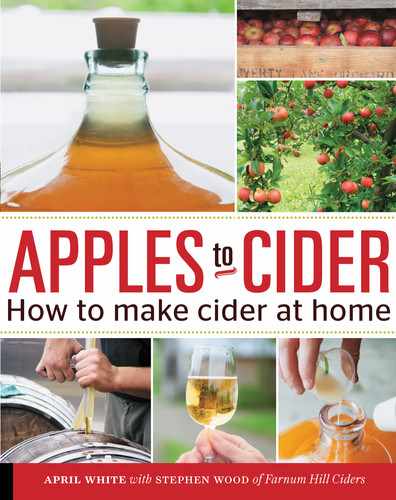

 CIDERMAKING TIP
CIDERMAKING TIP

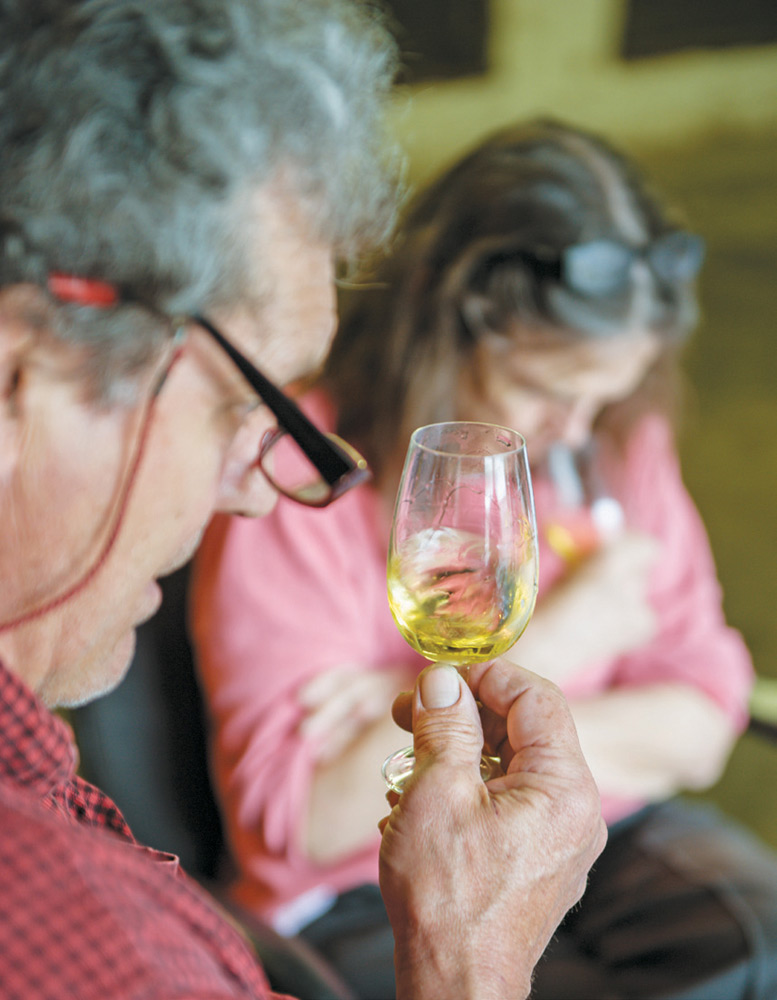



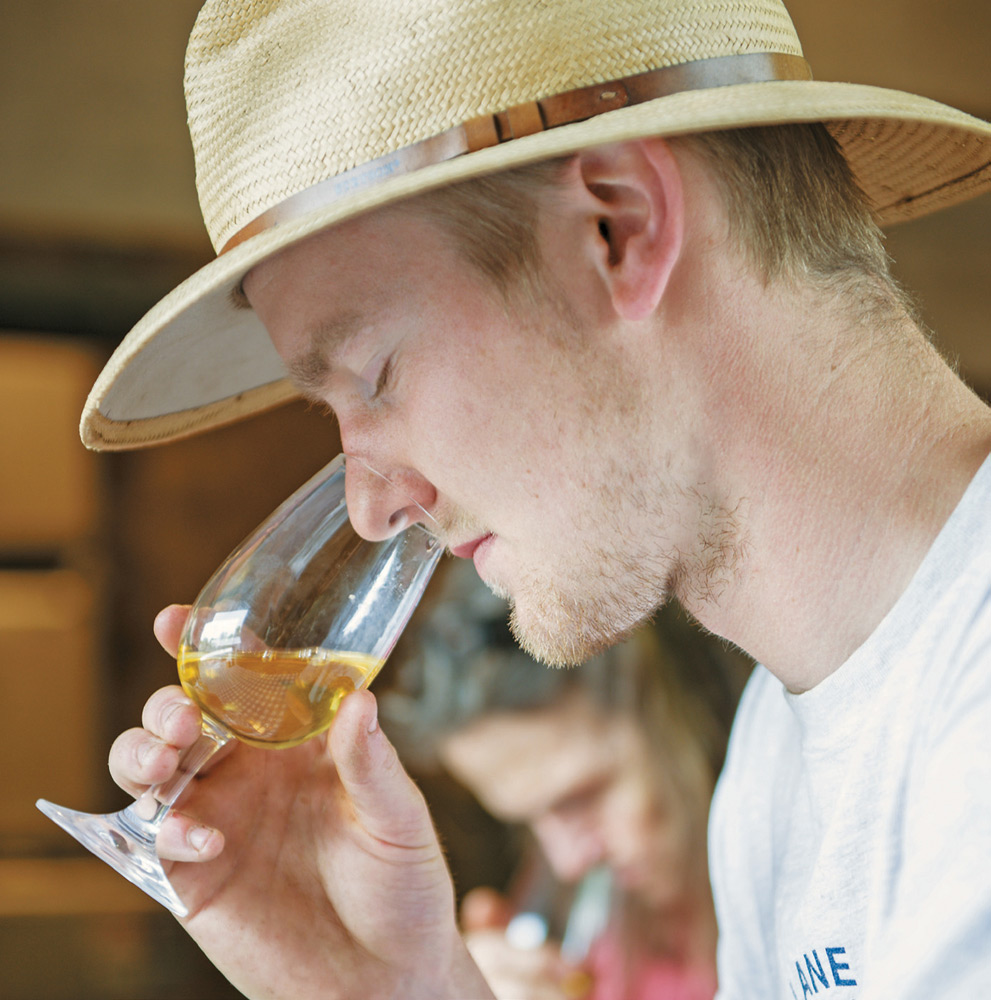
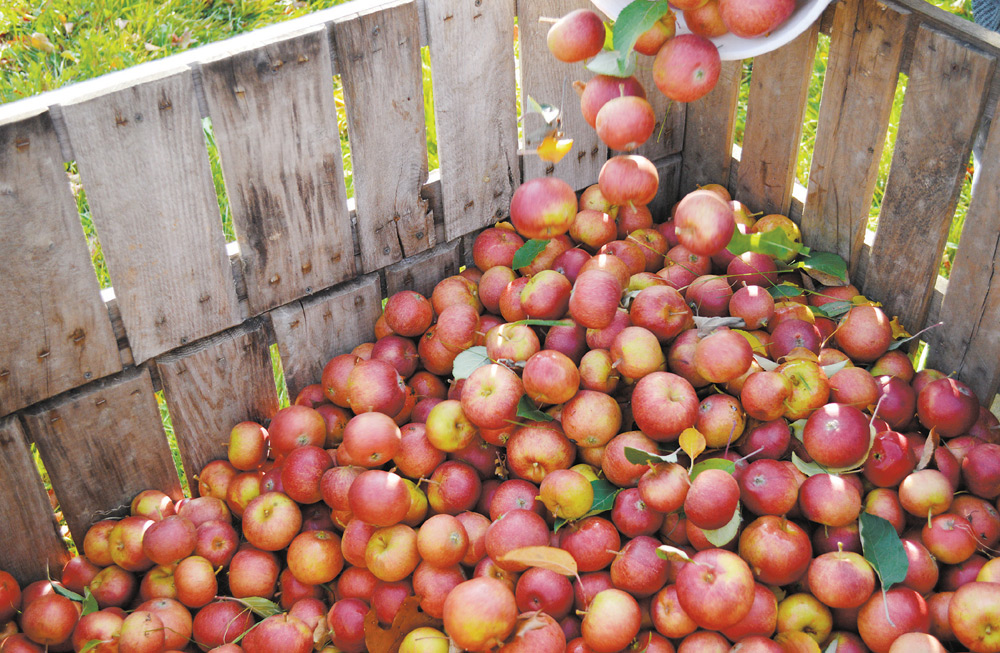
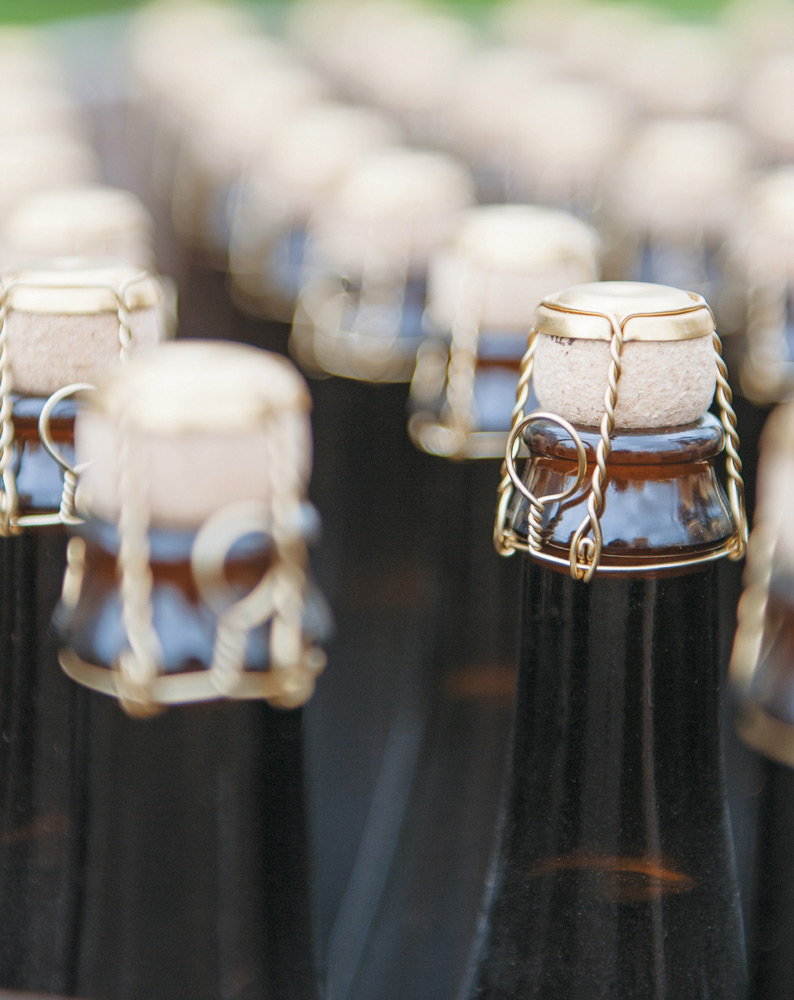

 NOTES FROM THE CIDERY, STEVE WOOD
NOTES FROM THE CIDERY, STEVE WOOD